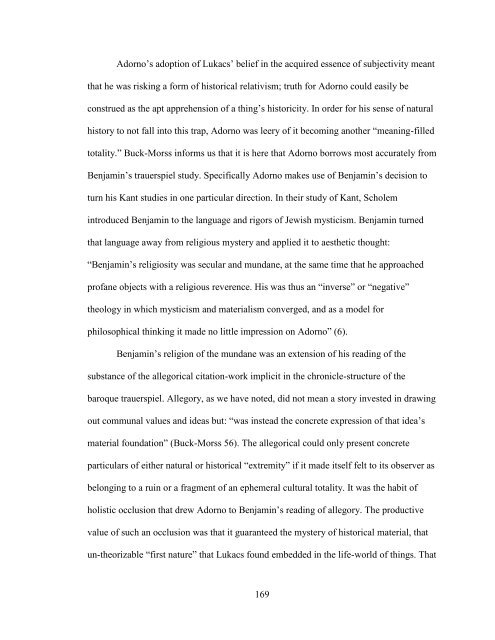TABOO: THE ACTUAL MODERNIST AESTHETIC, MADE REAL A ...
TABOO: THE ACTUAL MODERNIST AESTHETIC, MADE REAL A ...
TABOO: THE ACTUAL MODERNIST AESTHETIC, MADE REAL A ...
You also want an ePaper? Increase the reach of your titles
YUMPU automatically turns print PDFs into web optimized ePapers that Google loves.
Adorno‘s adoption of Lukacs‘ belief in the acquired essence of subjectivity meant<br />
that he was risking a form of historical relativism; truth for Adorno could easily be<br />
construed as the apt apprehension of a thing‘s historicity. In order for his sense of natural<br />
history to not fall into this trap, Adorno was leery of it becoming another ―meaning-filled<br />
totality.‖ Buck-Morss informs us that it is here that Adorno borrows most accurately from<br />
Benjamin‘s trauerspiel study. Specifically Adorno makes use of Benjamin‘s decision to<br />
turn his Kant studies in one particular direction. In their study of Kant, Scholem<br />
introduced Benjamin to the language and rigors of Jewish mysticism. Benjamin turned<br />
that language away from religious mystery and applied it to aesthetic thought:<br />
―Benjamin‘s religiosity was secular and mundane, at the same time that he approached<br />
profane objects with a religious reverence. His was thus an ―inverse‖ or ―negative‖<br />
theology in which mysticism and materialism converged, and as a model for<br />
philosophical thinking it made no little impression on Adorno‖ (6).<br />
Benjamin‘s religion of the mundane was an extension of his reading of the<br />
substance of the allegorical citation-work implicit in the chronicle-structure of the<br />
baroque trauerspiel. Allegory, as we have noted, did not mean a story invested in drawing<br />
out communal values and ideas but: ―was instead the concrete expression of that idea‘s<br />
material foundation‖ (Buck-Morss 56). The allegorical could only present concrete<br />
particulars of either natural or historical ―extremity‖ if it made itself felt to its observer as<br />
belonging to a ruin or a fragment of an ephemeral cultural totality. It was the habit of<br />
holistic occlusion that drew Adorno to Benjamin‘s reading of allegory. The productive<br />
value of such an occlusion was that it guaranteed the mystery of historical material, that<br />
un-theorizable ―first nature‖ that Lukacs found embedded in the life-world of things. That<br />
169
















